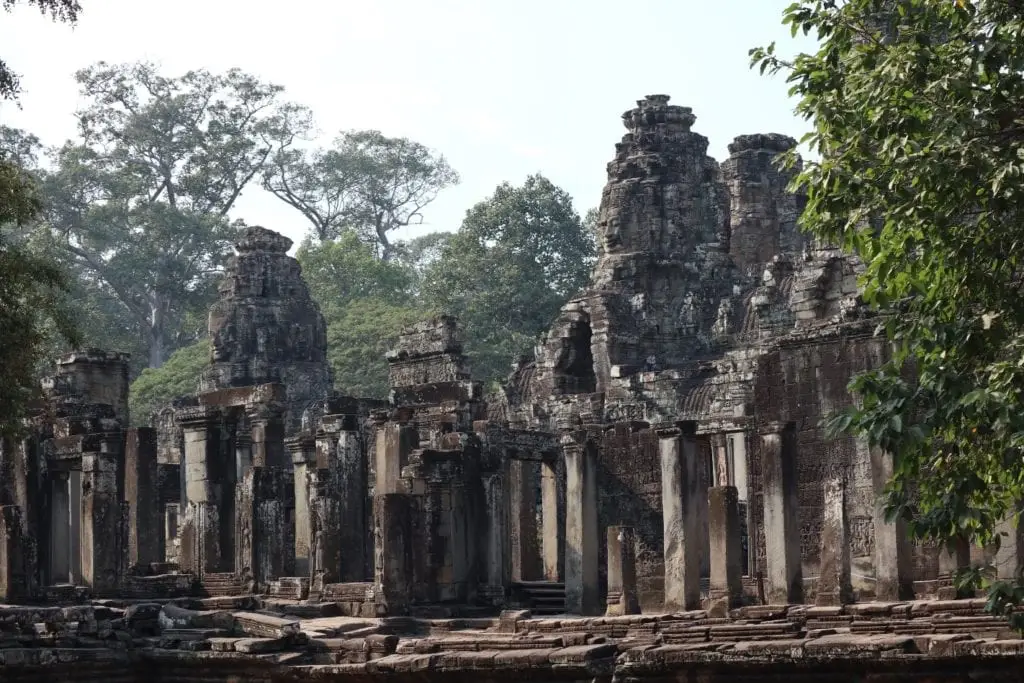The Allure of Tomb Raiders:
In the early 2000’s Angelina Jolie starred as Laura Croft, Adventurer, in a film called “Tomb Raiders”. In the movie her goal was to obtain ancient artifacts from the Illuminati. Ta Prohm Temple, in the Siem Reap area of Cambodia, hosted the filming of some scenes for the movie. This film followed on the heals of other movies, like the Indiana Jones Series, filmed in “exotic” locations in search of treasures and the “answer to the mysteries of life”. Isn’t this the true allure of travel? These movies make you want to travel to “outside the comfort zone” places. Southeast Asia, not just Cambodia, is mysteriously attractive and fascinating. So, not knowing of any other jungle temples to explore, we set out to discover the areas surrounding Siem Reap.
The City:
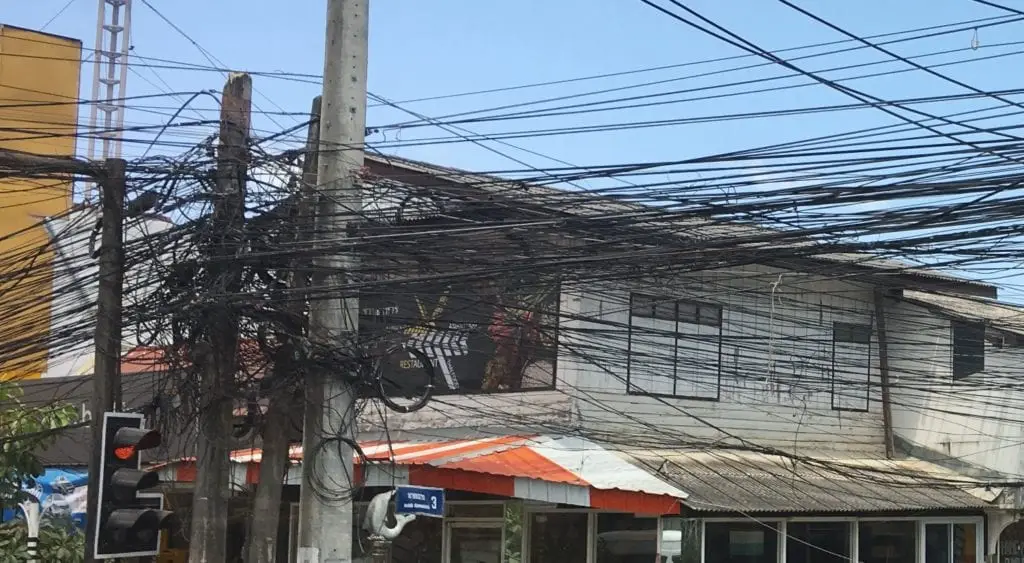
Siem Reap, located just 250 miles east of Bangkok Thailand, describes itself as a “Resort” city in northwestern Cambodia. This city of 250,000 people hardly fits the description most westerners associate with a Resort. The region has experienced significant growth because of the lure of its many beautiful cultural sites. Growth has out paced the ability of the city to provide services in a controlled and orderly manner. There are, however, several really good hotels in Siem Reap. We chose the Borei Angkor Resort & Spa because of its convenience to the center of the city and the amenities in the hotel.
The Temples:
We allowed 2+ days for our Siem Reap explorations during late February before heading on to Viet Nam. We had plenty of time to wander around the Siem Reap sites. Our days were hot and humid while the nights were cool. During the first day we realized we were not as prepared as we should have been. Local guides and transportation are essential and abundant. Tourist services at our hotel provided contacts with several recommended guides. The guides, if they are like the ones we had, only impart the basic highlights and not much of the back stories of each site. We spent most of our time at Ta Prohm, Angkor Thom, Angkor Wat and the Bayon Temple. The Ta Prohm Temple was unreal, like a Disney creation. The City of Angkor Thom (including the Bayon Temple) was vast, with many different temples to see and explore. Angkor Wat was incredibly impressive but had significant crowds of tourists.
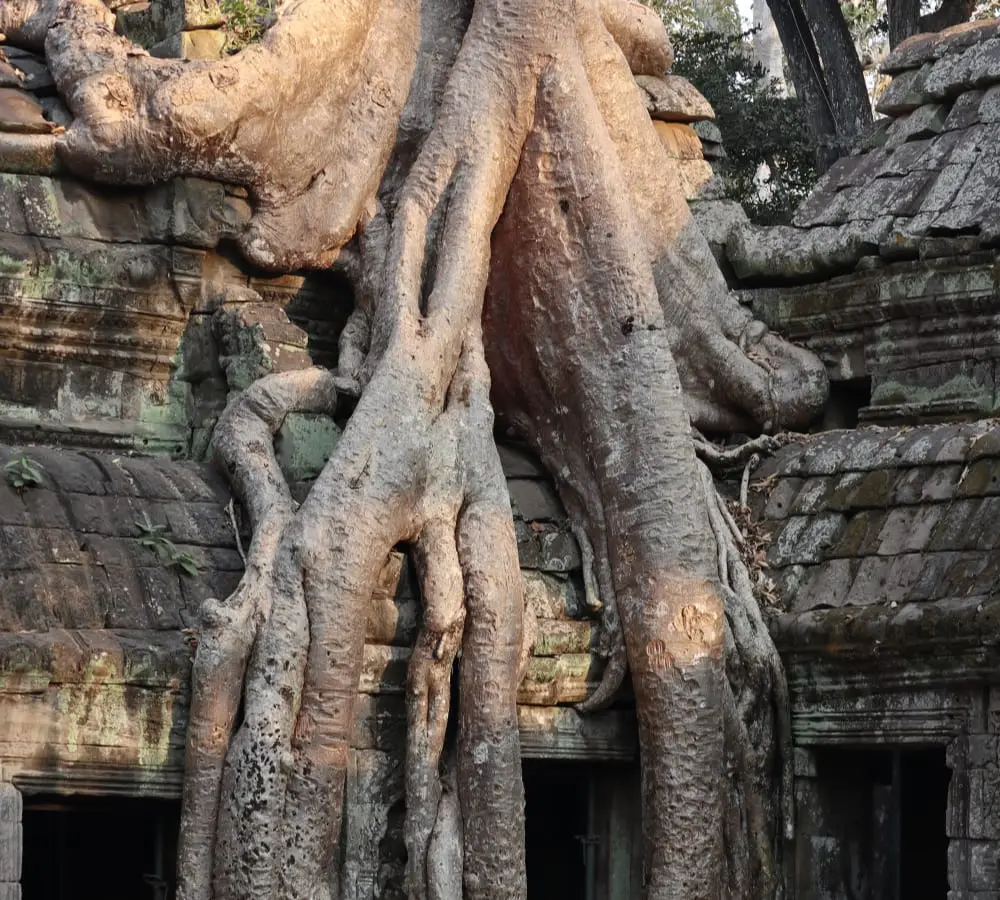
Ta Prohm with vegetation slowly taking over 
Angkor Wat’s massive structures 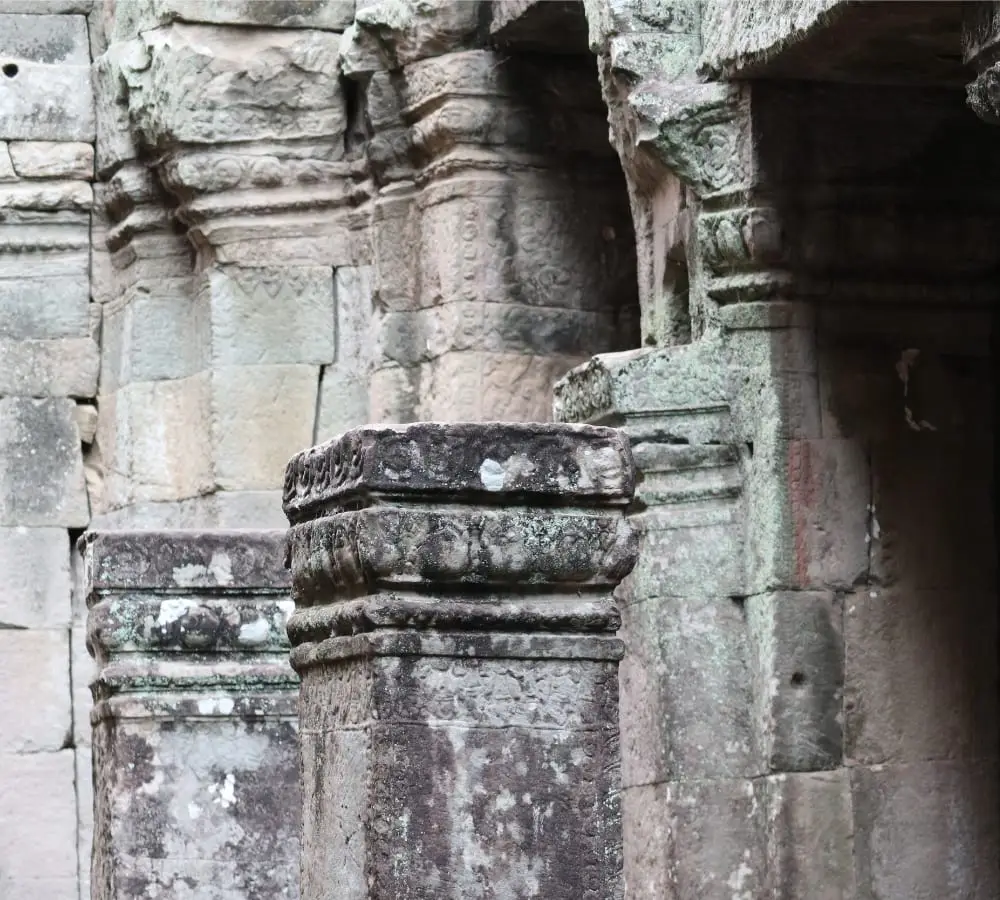
Bayon’s Incredible secret passageways 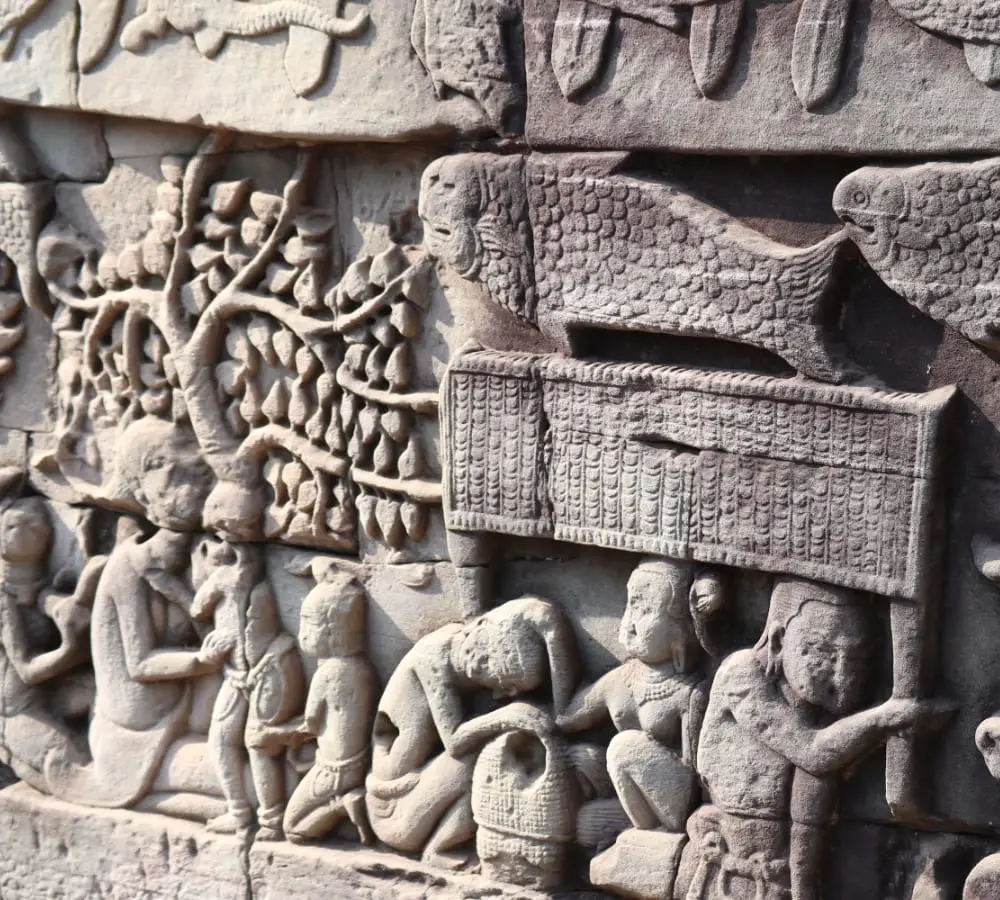
Very intricate bas relief 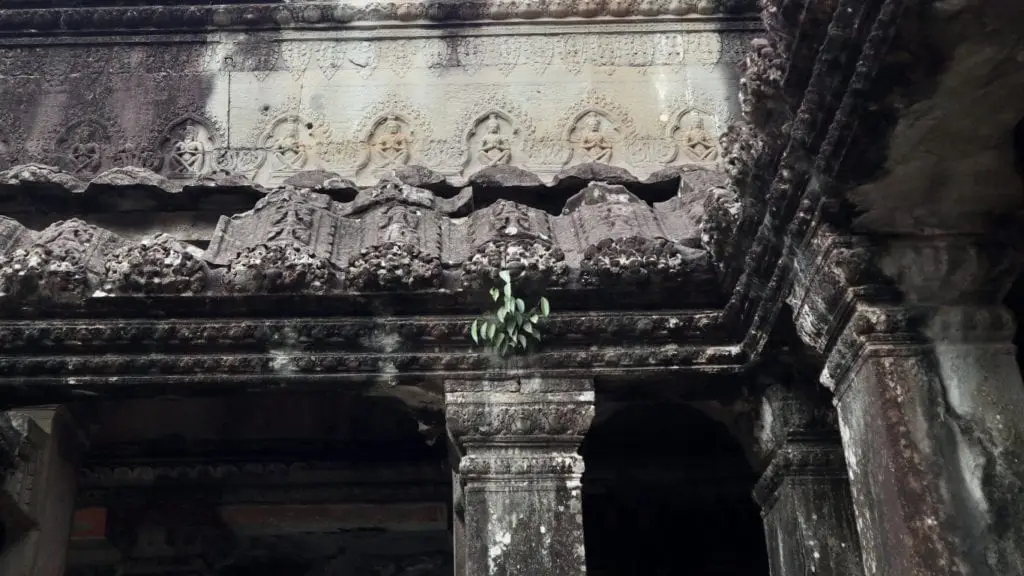
New life sprouts everywhere
Ta Prohm Temple:
Ta Prohm Temple is far from the tourist trails. King Jayavarman VII built this Buddhist temple in 1191 for his father. The Temple today appears the same way it looked when it was re-discovered. While Ta Prohm lay forgotten and neglected, the Cambodian jungle wasted no time in devouring it. Silk-cotton trees, also known as the Kapok trees, took root in the stones of the temple. The original construction somehow did not use mortar but survived quite well. The tree roots wind through the entire structure, creating an astonishing merger of nature and architecture.
French archaeologists rediscovered the Angkor Wat area in the mid 1800’s. All of the temples had become overgrown, but none so spectacularly as Ta Prohm. As the archaeologists excavated and restored the Ta Prohm Temple they had to make sure that the giant tree roots would not further deteriorate the structure or make it dangerous to visit. Ta Prohm looks like nature unfettered because of its appearance of neglect. Crews work very hard to maintain that “Neglected” look.
Angkor Thom:
Angkor Thom was not just one centrally located temple. It was a large city supporting a population estimated to be as high as 1 million people during the thirteenth century. Its main temple was the Bayon Temple. Keep in mind how significant this city was at that time. Only 70,000 people lived in London. Construction on Westminster Abbey, its main temple (church), started 300 years later.
Protection of the City’s 1 million residents apparently was very important. An 8 mile wall, 25 feet high surrounded the entire city. Outside the wall, a 400 foot wide moat provided additional protection. An earth embankment 82 feet wide supported the inner side of the wall and served as a road around the city. Most of that area is now nothing more than over grown vegetation. Since most of the original structures were made of wood, only some of the stone temples have survived
Entry towers and long causeways bisect each side of the City walls, except on the east, where are two entrances. On the East Side, where the causeway leads to the entry towers, there is a row of 108 stone figures guarding the City of Angkor Thom. 54 Demons are on the right side of the causeway and 54 gods are on the left. The demons have a grimacing expression and wear a military headdress whereas the gods look serene with their almond-shaped eyes and conical headdresses. A serpent like railing, held by the gods and demons, spans the length of each side of the causeway.
Bayon Temple:
Perhaps the most intriguing and most mesmerizing of the Angkor Thom temples is the Bayon Temple. It was the main temple in its day. It does not look like much from a distance. Closer, you see 54 towers, with 216 smiling faces peering down at you. Bayon is a fantastic temple to explore with its maze of tunnels, blocked doorways and tumble-down rocks. It is a perfect place to get lost in the mysteries of Angkor.
Angkor Wat:
Angkor Wat is an enormous Buddhist temple complex spread over 400 acres. It was originally built for the Hindu god, Vishnu. In the 12th century it became a Buddhist temple and served as the capital of the Khmer empire. Angkor Wat is one of the “True Wonders of the World”.
A 15-foot high wall, surrounded by a wide moat enclosed the temple. A sandstone causeway serves as the main access point for the temple. Thousands of bas-reliefs sculptures adorn the walls representing important deities and figures in the Hindu and Buddhist religions as well as key events in its narrative tradition. Restoration work is still on-going. It is accomplished in bits and pieces. Major efforts didn’t begin in earnest until the 1960s. By then, Cambodia was a country transitioning from colonial rule to a limited form of constitutional monarchy.
When Cambodia fell into a brutal civil war in the 1970s, Angkor Wat, somehow miraculously, sustained relatively minimal damage. The autocratic and barbarous Khmer Rouge regime battled troops from neighboring Vietnam in the area near the ancient city, and there are bullet holes marking its outer walls as a result. Since then, with the Cambodian government undergoing numerous changes, the international community, including representatives of India, Germany and France, have contributed to the ongoing restoration efforts.
Angkor Wat was named a UNESCO World Heritage site in 1992.

